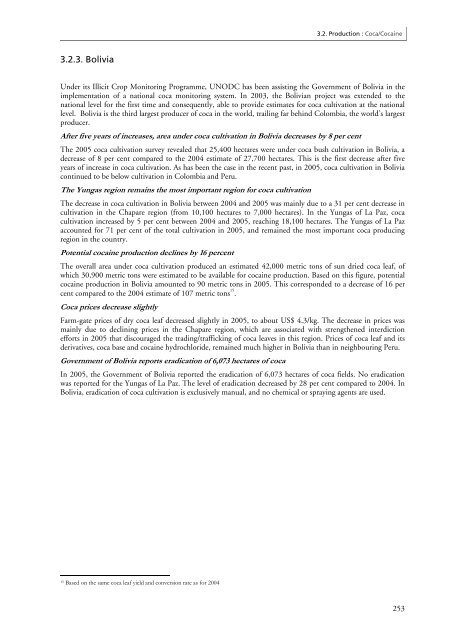World Drug Report 2006 - United Nations Office on Drugs and Crime
World Drug Report 2006 - United Nations Office on Drugs and Crime
World Drug Report 2006 - United Nations Office on Drugs and Crime
Create successful ePaper yourself
Turn your PDF publications into a flip-book with our unique Google optimized e-Paper software.
3.2. Producti<strong>on</strong> : Coca/Cocaine<br />
3.2.3. Bolivia<br />
Under its Illicit Crop M<strong>on</strong>itoring Programme, UNODC has been assisting the Government of Bolivia in the<br />
implementati<strong>on</strong> of a nati<strong>on</strong>al coca m<strong>on</strong>itoring system. In 2003, the Bolivian project was extended to the<br />
nati<strong>on</strong>al level for the first time <strong>and</strong> c<strong>on</strong>sequently, able to provide estimates for coca cultivati<strong>on</strong> at the nati<strong>on</strong>al<br />
level. Bolivia is the third largest producer of coca in the world, trailing far behind Colombia, the world’s largest<br />
producer.<br />
After five years of increases, area under coca cultivati<strong>on</strong> in Bolivia decreases by 8 per cent<br />
The 2005 coca cultivati<strong>on</strong> survey revealed that 25,400 hectares were under coca bush cultivati<strong>on</strong> in Bolivia, a<br />
decrease of 8 per cent compared to the 2004 estimate of 27,700 hectares. This is the first decrease after five<br />
years of increase in coca cultivati<strong>on</strong>. As has been the case in the recent past, in 2005, coca cultivati<strong>on</strong> in Bolivia<br />
c<strong>on</strong>tinued to be below cultivati<strong>on</strong> in Colombia <strong>and</strong> Peru.<br />
The Yungas regi<strong>on</strong> remains the most important regi<strong>on</strong> for coca cultivati<strong>on</strong><br />
The decrease in coca cultivati<strong>on</strong> in Bolivia between 2004 <strong>and</strong> 2005 was mainly due to a 31 per cent decrease in<br />
cultivati<strong>on</strong> in the Chapare regi<strong>on</strong> (from 10,100 hectares to 7,000 hectares). In the Yungas of La Paz, coca<br />
cultivati<strong>on</strong> increased by 5 per cent between 2004 <strong>and</strong> 2005, reaching 18,100 hectares. The Yungas of La Paz<br />
accounted for 71 per cent of the total cultivati<strong>on</strong> in 2005, <strong>and</strong> remained the most important coca producing<br />
regi<strong>on</strong> in the country.<br />
Potential cocaine producti<strong>on</strong> declines by 16 percent<br />
The overall area under coca cultivati<strong>on</strong> produced an estimated 42,000 metric t<strong>on</strong>s of sun dried coca leaf, of<br />
which 30,900 metric t<strong>on</strong>s were estimated to be available for cocaine producti<strong>on</strong>. Based <strong>on</strong> this figure, potential<br />
cocaine producti<strong>on</strong> in Bolivia amounted to 90 metric t<strong>on</strong>s in 2005. This corresp<strong>on</strong>ded to a decrease of 16 per<br />
cent compared to the 2004 estimate of 107 metric t<strong>on</strong>s 15 .<br />
Coca prices decrease slightly<br />
Farm-gate prices of dry coca leaf decreased slightly in 2005, to about US$ 4.3/kg. The decrease in prices was<br />
mainly due to declining prices in the Chapare regi<strong>on</strong>, which are associated with strengthened interdicti<strong>on</strong><br />
efforts in 2005 that discouraged the trading/trafficking of coca leaves in this regi<strong>on</strong>. Prices of coca leaf <strong>and</strong> its<br />
derivatives, coca base <strong>and</strong> cocaine hydrochloride, remained much higher in Bolivia than in neighbouring Peru.<br />
Government of Bolivia reports eradicati<strong>on</strong> of 6,073 hectares of coca<br />
In 2005, the Government of Bolivia reported the eradicati<strong>on</strong> of 6,073 hectares of coca fields. No eradicati<strong>on</strong><br />
was reported for the Yungas of La Paz. The level of eradicati<strong>on</strong> decreased by 28 per cent compared to 2004. In<br />
Bolivia, eradicati<strong>on</strong> of coca cultivati<strong>on</strong> is exclusively manual, <strong>and</strong> no chemical or spraying agents are used.<br />
15 Based <strong>on</strong> the same coca leaf yield <strong>and</strong> c<strong>on</strong>versi<strong>on</strong> rate as for 2004<br />
253
















